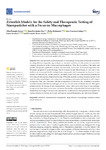Mostrar o rexistro simple do ítem
Zebrafish Models for the Safety and Therapeutic Testing of Nanoparticles with a Focus on Macrophages
| dc.contributor.author | Pensado-López, Alba | |
| dc.contributor.author | Fernández-Rey, Juan | |
| dc.contributor.author | Reimunde, Pedro | |
| dc.contributor.author | Crecente-Campo, José | |
| dc.contributor.author | Sánchez, Laura | |
| dc.contributor.author | Torres Andón, Fernando | |
| dc.date.accessioned | 2021-08-17T08:00:47Z | |
| dc.date.available | 2021-08-17T08:00:47Z | |
| dc.date.issued | 2021-07-09 | |
| dc.identifier.citation | Pensado-López, A.; Fernández-Rey, J.; Reimunde, P.; Crecente-Campo, J.; Sánchez, L.; Torres Andón, F. Zebrafish Models for the Safety and Therapeutic Testing of Nanoparticles with a Focus on Macrophages. Nanomaterials 2021, 11, 1784. https://doi.org/10.3390/nano11071784 | es_ES |
| dc.identifier.issn | 2079-4991 | |
| dc.identifier.uri | http://hdl.handle.net/2183/28257 | |
| dc.description | Review | es_ES |
| dc.description.abstract | [Abstract] New nanoparticles and biomaterials are increasingly being used in biomedical research for drug delivery, diagnostic applications, or vaccines, and they are also present in numerous commercial products, in the environment and workplaces. Thus, the evaluation of the safety and possible therapeutic application of these nanomaterials has become of foremost importance for the proper progress of nanotechnology. Due to economical and ethical issues, in vitro and in vivo methods are encouraged for the testing of new compounds and/or nanoparticles, however in vivo models are still needed. In this scenario, zebrafish (Danio rerio) has demonstrated potential for toxicological and pharmacological screenings. Zebrafish presents an innate immune system, from early developmental stages, with conserved macrophage phenotypes and functions with respect to humans. This fact, combined with the transparency of zebrafish, the availability of models with fluorescently labelled macrophages, as well as a broad variety of disease models offers great possibilities for the testing of new nanoparticles. Thus, with a particular focus on macrophage–nanoparticle interaction in vivo, here, we review the studies using zebrafish for toxicological and biodistribution testing of nanoparticles, and also the possibilities for their preclinical evaluation in various diseases, including cancer and autoimmune, neuroinflammatory, and infectious diseases. | es_ES |
| dc.description.sponsorship | Xunta de Galicia; ED481A-2018/095 | es_ES |
| dc.description.sponsorship | A.P.-L. is supported by the Xunta de Galicia Pre-doctoral Fellowship (ED481A-2018/095); F.T.A. is recipient of a grant by the AECC (“Asociación Española Contra el Cáncer”, Spain). J.F.-R. was supported by a scholarship awarded by “Fundación Barrié”. | |
| dc.language.iso | eng | es_ES |
| dc.publisher | MDPI | es_ES |
| dc.relation.uri | https://doi.org/10.3390/nano11071784 | es_ES |
| dc.rights | Atribución 4.0 Internacional (CC BY 4.0) | es_ES |
| dc.rights.uri | https://creativecommons.org/licenses/by/4.0/ | * |
| dc.subject | Zebrafish | es_ES |
| dc.subject | Nanomaterial | es_ES |
| dc.subject | Nanoparticle | es_ES |
| dc.subject | Drug delivery | es_ES |
| dc.subject | Macrophage | es_ES |
| dc.subject | Immune system | es_ES |
| dc.subject | Innate immunity | es_ES |
| dc.title | Zebrafish Models for the Safety and Therapeutic Testing of Nanoparticles with a Focus on Macrophages | es_ES |
| dc.type | info:eu-repo/semantics/article | es_ES |
| dc.rights.access | info:eu-repo/semantics/openAccess | es_ES |
| UDC.journalTitle | Nanomaterials | es_ES |
| UDC.volume | 11 | es_ES |
| UDC.issue | 7 | es_ES |
| UDC.startPage | 1784 | es_ES |
| dc.identifier.doi | 10.3390/nano11071784 |
Ficheiros no ítem
Este ítem aparece na(s) seguinte(s) colección(s)
-
II - Artigos [569]






